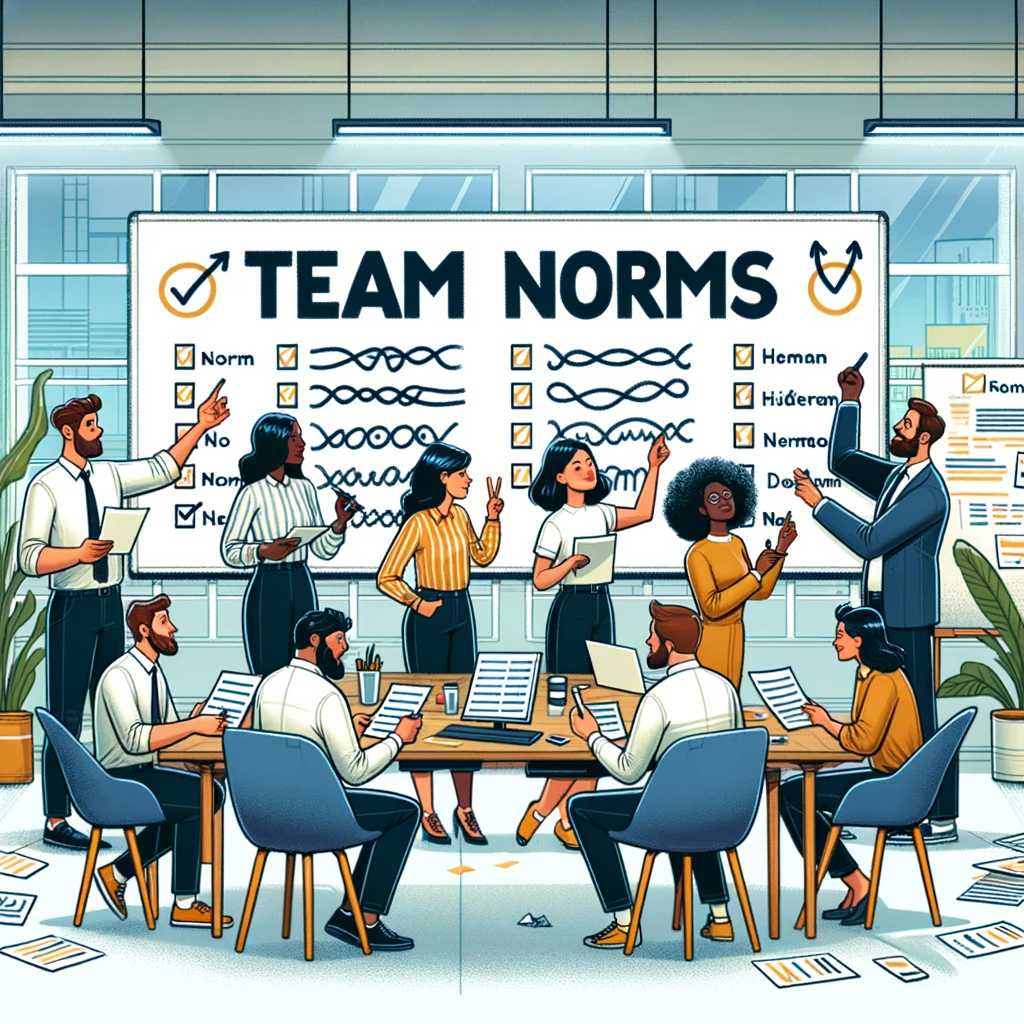Have you ever found yourself in a Zoom meeting, coffee in hand, wondering how that new colleague from across the globe takes their morning brew? Or maybe, you’ve silently pondered why Sam always prefers texting, while Malik loves those long, detailed emails?
Welcome to the fascinating world of modern team dynamics! ?
We’re no longer in the era of a nine-to-five, where everyone clocks in and out at the same office. Nope, the game has changed. From bustling startups in shared workspaces to corporate giants with teams spanning continents, the way we work and communicate has seen a revolutionary shift. And, as with any revolution, there come challenges (with a generous sprinkle of opportunities!).
Perhaps you’ve noticed how the lines of communication can sometimes get tangled? Or sensed that unspoken tension in a team chat? Yep, we’ve all been there. But here’s the kicker: It’s not just about the challenges. It’s about understanding and harnessing the potential of these diverse, dynamic teams we’re all a part of.
Stick around, and let’s delve into what makes modern teams tick, how we can foster environments where everyone feels they belong, and most importantly, how to ensure our feedback doesn’t land like a lead balloon. ?
Ready to learn more? Let’s get the ball rolling!

The Evolving Landscape of Team Dynamics
Alright, so before we get into the nitty-gritty of why Tina from HR is hesitant to speak up in meetings or why Chris from finance seems to have an aversion to Slack, let’s take a trip down memory lane. ?️
Remember the good ol’ days? Teams gathered in those slightly-too-cold conference rooms, there was that one squeaky chair everyone avoided, and water cooler chats were about last night’s game or the latest office gossip. But fast forward to now, and boy, things look a tad different, don’t they?
The Digital Shift

First off, welcome to the era of endless video calls and digital tools. We’ve traded the water cooler for virtual breakout rooms. And hey, no judgment if you’re in pajamas from the waist down during that team catch-up (we’ve all been there)!
Diverse and Widespread
Team diversity isn’t just a buzzword. From Tina in Texas to Monika in Mumbai, teams today span cultures, time zones, and a whole lot of varied life experiences. It’s like a global potluck, but instead of dishes, everyone’s bringing their unique perspectives to the table. ?
New Challenges, Who Dis?
With all this change comes a set of fresh challenges. How do we ensure everyone feels heard? How do we navigate time zones without burning out? And seriously, how many messaging apps are too many?
But here’s the silver lining: While the game has changed, the rules aren’t set in stone. There’s room to explore, innovate, and, most importantly, find what works best for us and our unique teams.
So, as we stand at the crossroads of the traditional and the modern, let’s arm ourselves with the knowledge and strategies to not just navigate but truly thrive in this new age of team dynamics!
Onward, intrepid explorer! ?
Psychological Safety: The Foundation of High-Performing Teams
So, let’s have some real talk. Ever been in a meeting where you had this *amazing* idea (the kind that could probably earn you that promotion) but something held you back from voicing it? Or maybe you’ve been in situations where a teammate made a mistake but was too scared to admit it, and the entire project took a hit?
Enter the world of Psychological Safety. No, it’s not the title of a new Netflix thriller. It’s something way cooler (and more important for our daily work lives!).
What’s the Big Deal About Psychological Safety? ?

Think of it as the magic ingredient in the team cocktail. Psychological Safety is the difference between teams where everyone’s walking on eggshells and those where ideas flow like a waterfall. Essentially, it’s all about feeling safe to take risks, voice opinions, or admit mistakes without the fear of being punished or ridiculed.
Why Should We Care?
Well, apart from the obvious fact that nobody wants to feel like they’re tip-toeing around landmines at work, research (yeah, actual sciencey stuff!) shows teams with high psychological safety outperform their counterparts. They’re more innovative, more cohesive, and, let’s face it, way more fun to be a part of.
The Impact of Missing Out
Without this foundation, you might as well be building your team’s house on sand. Lack of psychological safety can lead to holding back ideas, a fear of admitting errors, and an atmosphere that’s, well, kind of stifling.
But hey, don’t sweat it too much! Recognizing the importance is the first step. And luckily for us, there’s a bunch we can do to foster this environment, which, spoiler alert, we’ll delve deep into in our upcoming sections.
So, whether you’re Sam at a startup trying to build a fearless team from scratch, or Chris from corporate aiming to rejuvenate an old one, understanding and championing psychological safety is your golden ticket!
Cheers to building teams where everyone feels at home! ?
Team Norms: The Unspoken Rules that Govern Successful Teams
Alright, let’s play a quick game. Think about your favorite sports team. Now, imagine if every player just did their own thing without any strategy or coordination. Chaos, right? That’s precisely what happens when teams at work don’t have established norms. ?
Setting the Stage with Team Norms:
So, what are these elusive “team norms”? Picture them as a playbook that everyone on the team follows – from how we communicate to how often we communicate and maybe even when we take our coffee breaks (but highly unlikely). It’s like having an internal GPS that helps everyone navigate the daily hustle and bustle of teamwork.

The Good, the Bad, and the Ugly of Team Norms:
Every team has norms, whether they realize it or not. The best norms streamline collaboration and make sure everyone’s on the same page. But, on the flip side, negative norms (like responding to emails at midnight or dodging responsibility) can sneak in and create an unhealthy work culture faster than you can say “Team Retreat!”
Crafting Team Norms that Rock:
Great news, team leaders and aspiring leaders! You have the power to shape these norms. It’s not about a top-down decree but rather co-creating norms with your team. Remember, a team norm that’s co-created is more likely to be respected and followed. Individual buy-in and compliance are fostered through the process of co-creation.
Here’s a shoutout to Transformational Tina and Mindful Mohammed: the way you facilitate and shape these norms can be a game-changer! Whether it’s making space for regular team check-ins, setting boundaries for after-hours communication, or simply celebrating small wins together, the devil (and the delight) is in the details.
In the grand orchestra that is teamwork, norms are the rhythm section, setting the pace and ensuring everyone can create beautiful music together. So, let’s dive into understanding them better and making them work for us!
Tuning our instruments and getting ready for a harmonious work melody! ?
Giving and Receiving Feedback: An Art and a Science
Pop quiz! Which is more nerve-wracking:
a) Jumping out of an airplane (with a parachute, of course!) ; or
b) Giving or receiving feedback at work?
If you chose ‘b’, trust me, you’re not alone! ?
Feedback: The Double-Edged Sword:

Feedback, in its essence, is a powerful tool. It can propel our personal growth, refine team processes, and even transform the trajectory of entire projects. But, let’s be honest: it can also sting. It’s like receiving a gift. Sometimes it’s exactly what you’ve always wanted, and other times it’s… well, a pair of mismatched socks.
Enter Radical Candor:
Ever heard of the term, “Radical Candor”? It’s a fabulous approach coined by Kim Scott, and it’s all about delivering feedback that’s both direct and caring. Imagine a sweet spot between being aggressively blunt and passively sugarcoating things. That’s Radical Candor. It means you care enough about the person to be honest, yet you do it with genuine empathy and respect.
Avoiding the Feedback Faux Pas:
We’ve all either given or received feedback that missed the mark. Maybe it was too vague (“Great job!”) or overly critical without being constructive (“This just isn’t good enough”). The trick? Be specific, be timely, and always ensure there’s a clear path forward. Oh, and always check in with how it’s received—you might be surprised at what you learn!
Receiving Like a Pro:
Let’s flip the script. Getting feedback isn’t just about nodding and moving on. It’s an active process. Ask questions, seek clarity, and most importantly, view it as a learning opportunity, not criticism. Remember, every piece of feedback is a brick in the pathway to your growth.
For all the go-getters and trailblazers out there (looking at you, Startup Sam and Transformational Tina!), mastering the art of feedback with a touch of Radical Candor can be your secret weapon. It fosters a culture where everyone feels valued and growth is a collective journey.
So, let’s toast to feedback that uplifts, enlightens, and propels us forward! ?
Psychometric Assessments: Your Team’s Secret Decoder Ring

Do you remember those decoder rings from cereal boxes or kids’ spy kits? You know, the ones that helped decipher secret messages? In many ways, psychometric assessments are the adult version of those rings—helping us decode the complexities of human behavior and team communication. ?️♂️
Cracking the Code with Assessments:
Ever wondered why Manager Mike always craves detailed data before making decisions, while Creative Carla thrives in spontaneous brainstorm sessions? Enter psychometric assessments. These tools aren’t about labeling or putting people in boxes; they’re about understanding and celebrating our unique make-up.
A Quick Dive into Popular Tools:
Hogan: Known for its in-depth personality insights, Hogan delves into our day-to-day personality, how we respond under stress, and our core values. It’s like having a map that shows where each team member shines brightest and where they might need a bit of support.
Emergenetics: This gem taps into our thinking and behavioral preferences. Do you process information analytically or more intuitively? Are you more assertive or more flexible in your approach? Emergenetics helps teams appreciate the cognitive diversity that each member brings to the table.
DiSC: A classic! Focused on communication and behavior, DiSC categorizes preferences into Dominance, Influence, Steadiness, and Conscientiousness. Imagine knowing how to tailor your communication so that it resonates with each team member. DiSC can help pave the way!
Why Bother with Assessments?
These aren’t just fancy reports to gather dust on a shelf. They’re dynamic tools that, when used effectively, can enhance team cohesion, improve communication, and even reduce conflicts. It’s like having a user manual for each team member, allowing for smoother collaboration and understanding.
And for the leaders out there—Transformational Tina, Mindful Mohammed, and yes, even Skeptical Steve—these assessments can be instrumental. They provide insights, spark meaningful conversations, and act as catalysts for team growth.
So, ready to decode the wonderful tapestry of personalities and preferences in your team? With the right tools, you’re set to unlock levels of synergy you never thought possible! ?️
Signs Your Team Might Need a Harmony Boost
Okay, time for some heart-to-heart. Every team faces hiccups. But how do you know when it’s just a minor speed bump or a sign of deeper issues that could benefit from a little expert guidance? Let’s unravel some common signs that your team might be sending out an SOS for our Team Harmony Training. ?
Communication Breakdowns:
You know that frustrating feeling when it seems like everyone’s speaking a different language, even though you’re all supposedly speaking English? Or when messages get lost, misinterpreted, or ignored? These communication hiccups can be a sign that there’s room to improve.
Read more about team communications in our Building a Culture of Open Communication article.
Walking on Eggshells:

If your team members are hesitant to speak up, share ideas, or admit mistakes, it might hint at a lack of psychological safety. Remember, a thriving team is one where everyone feels they can voice their thoughts without fear.
Feedback Fears:
Is feedback in your team often taken personally? Do people get defensive? Or maybe it’s avoided altogether? When giving or receiving feedback feels like navigating a minefield, it’s a cue that some training in constructive communication could be a game-changer.
Mismatched Expectations:
Are team norms unclear or causing friction? If members often seem out of sync or there are frequent misunderstandings about roles, responsibilities, or goals, it’s a tell-tale sign that it’s time to establish or re-evaluate team norms.
Personality Clashes:
Every team has a variety of personalities, which is awesome for diversity of thought! But if these differences lead to frequent conflicts or misunderstandings, it might be time to dive deeper into understanding and appreciating each team member’s unique strengths and preferences.
Recognize any of the above in your team? Don’t worry, many teams do. And that’s precisely where our Team Harmony Training shines.
Introducing: Team Harmony Training:

Designed with the modern team in mind, Learngsitics Team Harmony training programs addresses these very challenges head-on. Through modules on Psychological Safety, Team Norms, Giving & Receiving Feedback, and even incorporating insights from top-tier psychometric assessments, we’re all about nurturing an environment where teams don’t just function—they flourish.
For those leaders who’ve always felt that their teams had untapped potential, or those who are starting fresh and want to build solid foundations, our training offers the tools, insights, and strategies to create harmony, boost productivity, and, above all, foster a workplace where everyone thrives.
Here’s to recognizing the signs, taking proactive steps, and tuning your teams into the harmonious melody of collaboration and growth! ?
Real Stories, Real Impact: What Teams are Saying About Team Harmony Training
We can shout from the rooftops about the value of our training, but let’s face it—nothing beats hearing from those who’ve experienced it firsthand. Take a peek at what some recent participants have to say about Team Harmony Training. ?
Testimonial from Sarah, Project Manager at TechTitan Inc.:
“When we started the Team Harmony Training, I’ll admit I was skeptical. I’ve been through countless team-building workshops, and while they were fun, the effects were often short-lived. But this? This was different. The modules on psychological safety and feedback were game-changers for us. Our team’s communication has seen a 180-degree turn, and the atmosphere is noticeably more positive and collaborative. Thank you for this invaluable experience!”
Testimonial from Raj, Lead Designer at CreativeCanvas Studios:
“I always felt our team had a lot of untapped potential. The training helped us understand each other’s strengths and quirks, especially with the insights from the DiSC assessment. We’ve learned to lean into our diversity, and the results are evident in the quality of work we’re producing now. Can’t recommend Team Harmony Training enough!”
Testimonial from Laura, HR Manager at GreenLeaf Enterprises:
“Our company believes in continuous learning, and we’ve invested in numerous training programs over the years. But the Team Harmony Training stands out. The focus on team norms and the practical tips shared have been transformative. I’ve seen teams become more cohesive, efficient, and, most importantly, happier in their collaborations. It’s a win-win for everyone!”
There you have it—straight from the horse’s mouth! These stories underline the tangible, positive shifts teams experience after diving into our training modules. Whether it’s enhancing communication, building trust, or just understanding each other a tad bit better, the ripple effects of investing in team harmony are profound.
Thinking about giving your team that much-needed boost? Listen to Sarah, Raj, and Laura. Your team’s success story could be the next one we feature! ?
Ready to Elevate Your Team’s Harmony? Let’s Talk!

Teams are at the heart of every successful venture. The strength of their collaboration, communication, and cohesion often sets the stage for the success of projects, goals, and organizational milestones. If you’ve resonated with what you’ve read, or if you recognize some of the challenges we’ve mentioned within your team, it might be time to take proactive steps.
We’re not just about training; we’re about transformations. Our Team Harmony Training is designed to address the unique challenges teams face, ensuring they’re not just functioning, but flourishing.
Why wait for challenges to escalate? Let’s get ahead of them together.
? Schedule a Call Today
Reach out to our expert facilitators for a no-obligation chat. Whether it’s to explore training possibilities, understand the modules in-depth, or just to discuss potential team challenges you’re facing, we’re here to listen and guide.
? Click here to set up a call with our team
Seize the opportunity to cultivate a team environment that’s conducive to growth, creativity, and harmony. Let’s make the workplace a space where everyone thrives!

Recommended Reading to Deepen Your Team Harmony Journey
“The Fearless Organization: Creating Psychological Safety in the Workplace for Learning, Innovation, and Growth” by Amy C. Edmondson
- Dive deep into the concept of psychological safety and its significance in fostering innovation and growth in organizations.
“Radical Candor: Be a Kick-Ass Boss Without Losing Your Humanity” by Kim Scott
- A guide to providing direct, honest feedback while also showing you care deeply about your team members.
“The Five Dysfunctions of a Team: A Leadership Fable” by Patrick Lencioni
- Lencioni unveils the foundational elements that derail teams and provides actionable insights on how to overcome these challenges.
“Drive: The Surprising Truth About What Motivates Us” by Daniel H. Pink
- Gain insights into what truly motivates us at work and how to harness that knowledge to foster a more engaged and productive team.
“Quiet: The Power of Introverts in a World That Can’t Stop Talking” by Susan Cain
- Understand the value introverts bring to teams and organizations and how to create an environment where they thrive.
“Thanks for the Feedback: The Science and Art of Receiving Feedback Well” by Douglas Stone and Sheila Heen
- Delve into the intricacies of receiving feedback, understanding it, and using it for personal growth.
“Personality Plus: How to Understand Others by Understanding Yourself” by Florence Littauer
- A fun and insightful read into different personality types, aiding in understanding and appreciating team dynamics.
“DISC: The Universal Language of Behavior” by John G. Geier and Dorothy E. Downey
- Get acquainted with the DISC framework and learn how to apply it effectively in team settings.
“Emergenetics: Tap Into the New Science of Success” by Geil Browning
- Explore the science behind Emergenetics and how it can be used to enhance team collaboration and performance.
“Hogan Personality Inventory Manual” by Robert Hogan and Joyce Hogan
- A deep dive into the Hogan assessment, offering insights into interpreting and leveraging results for team development.
Remember, as with any journey, continued learning and exploration can only enrich your experience. These reads are a great starting point, offering both foundational knowledge and advanced insights to elevate your team’s harmony and success. ?




